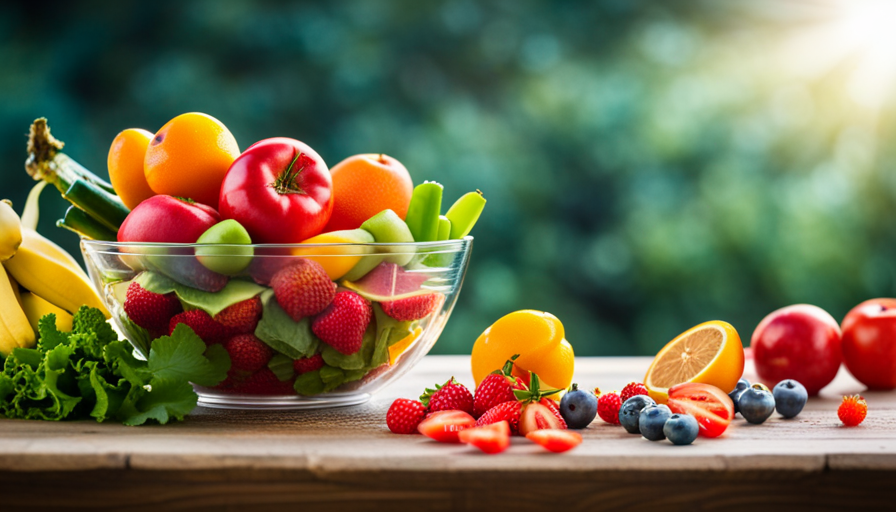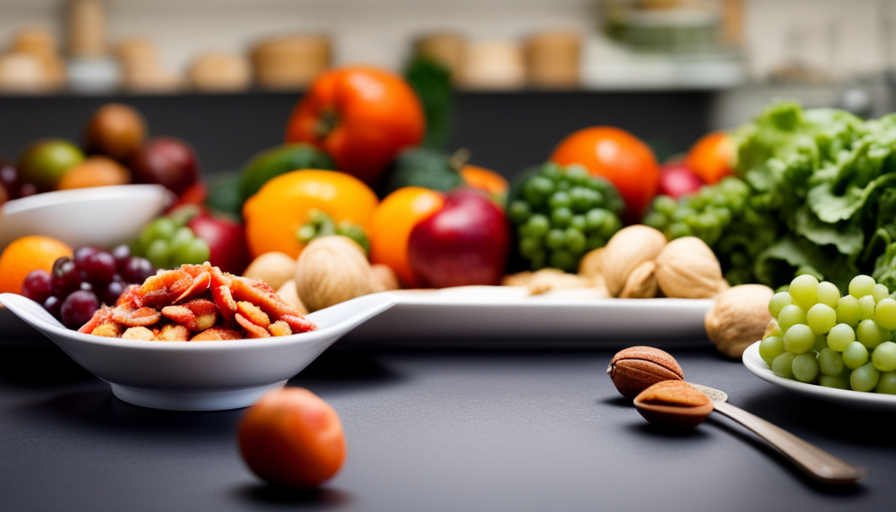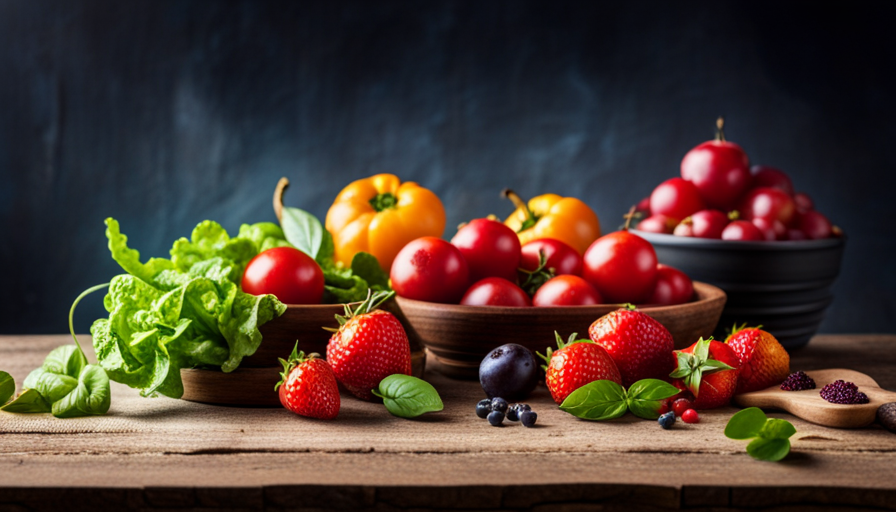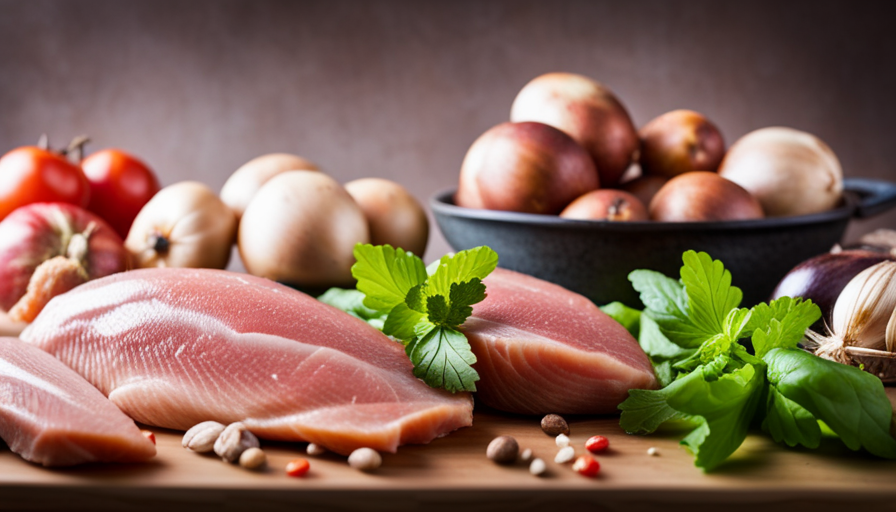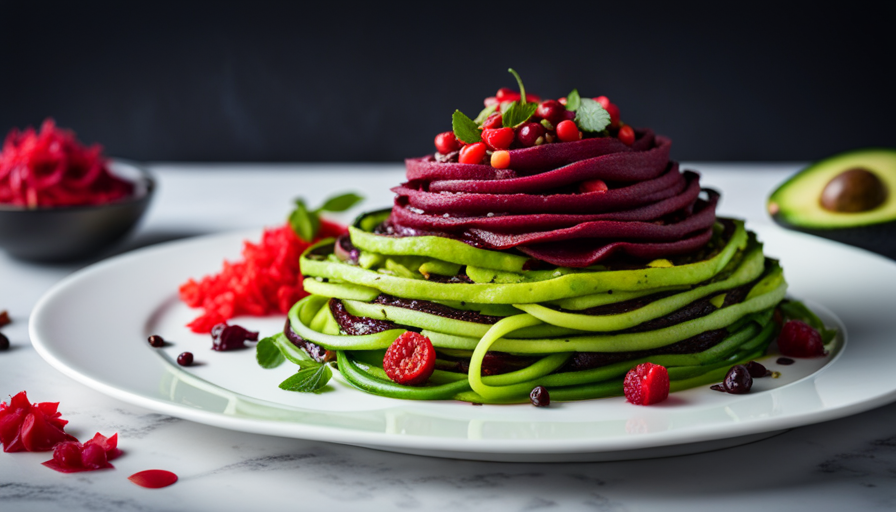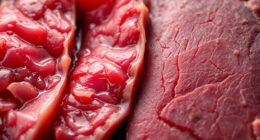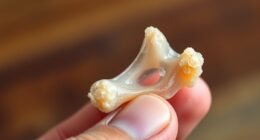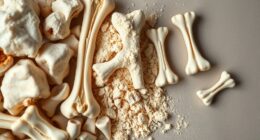Can you picture what it would be like to eat food in its purest form, just the way nature intended?
Well, let me tell you about the raw food diet, a way of eating that has gained popularity in recent years. The theory behind this diet is that cooking food destroys its natural enzymes and nutrients, so by consuming raw and unprocessed foods, you can maximize their health benefits.
One of the leading advocates of the raw food diet is FullyRawKristina, a vibrant and energetic woman who has inspired countless individuals to embrace this lifestyle.
In this article, we will explore the basics of the raw food diet, including its benefits, how to get started, and what to eat. We will also address common misconceptions and share success stories of those who have thrived on this way of eating.
So, if you’re curious about the raw food diet and its potential impact on your health, keep reading!
Key Takeaways
- Raw food diet emphasizes consuming uncooked and unprocessed foods.
- Raw foods are rich in essential nutrients.
- Benefits of eating raw and unprocessed foods include improved digestion, enhanced nutrient intake, weight loss, increased energy levels, and reduced risk of chronic diseases.
- Transitioning and maintaining a raw food diet requires dedication and commitment.
Overview of the Raw Food Diet
So, what’s the deal with the raw food diet anyway? The raw food diet is a way of eating that emphasizes the consumption of uncooked and unprocessed foods. Proponents of this diet claim that it provides numerous health benefits and can lead to weight loss, increased energy levels, and improved digestion. However, there are also some misconceptions surrounding the raw food diet.
One of the main benefits of eating raw and unprocessed foods is that they’re rich in essential nutrients. Cooking can destroy some of the vitamins and minerals in food, so eating them raw ensures that you’re getting the maximum nutritional value. Additionally, raw foods are typically low in calories and high in fiber, which can aid in weight loss and help maintain a healthy weight.
Despite these benefits, there are some misconceptions about the raw food diet. Some people believe that it’s restrictive and difficult to follow, but in reality, there’s a wide variety of delicious and nutritious raw food options available. Others worry about the safety of eating raw foods, but with proper food handling and preparation techniques, the risk of foodborne illnesses can be minimized.
The raw food diet offers several benefits, including increased nutrient intake and weight management. However, it’s important to be aware of the misconceptions surrounding this diet. Now let’s explore the specific benefits of eating raw and unprocessed foods.
Benefits of Eating Raw and Unprocessed Foods
Indulging in a diet abundant with unprocessed and raw foods can leave you feeling vibrant, energized, and filled with a newfound sense of vitality. The health benefits of consuming raw and unprocessed foods are numerous. Here are five reasons why incorporating these foods into your diet can be beneficial:
-
Improved Digestion: Raw foods are rich in fiber, which aids in digestion and helps prevent constipation.
-
Enhanced Nutrient Intake: When foods are cooked, they can lose some of their essential nutrients. Eating raw foods ensures that you’re getting the maximum amount of vitamins, minerals, and enzymes.
-
Weight Loss: Raw foods are often lower in calories and higher in fiber, making them a great choice for weight management.
-
Increased Energy Levels: Raw foods provide a natural source of energy, as they’re easily digested and contain essential nutrients.
-
Reduced Risk of Chronic Diseases: Studies have shown that a diet rich in raw and unprocessed foods can lower the risk of developing chronic diseases, such as heart disease and certain types of cancer.
Transitioning from an unhealthy diet to a raw food lifestyle has been the journey of FullyRawKristina, who’s now advocating for the benefits of raw and unprocessed foods.
FullyRawKristina’s Journey and Advocacy
Embarking on my transformative trek, I passionately promote the power and perks of embracing a plant-based lifestyle. My health journey began when I discovered the incredible benefits of raw and unprocessed foods.
As FullyRawKristina, I have become a prominent figure in the raw food movement, inspiring countless individuals to make positive changes in their lives.
Through my own experiences, I’ve witnessed the remarkable impact that a raw food diet can have on overall health and well-being. By consuming a variety of fresh fruits, vegetables, nuts, seeds, and sprouts, I’ve experienced increased energy levels, improved digestion, and a strengthened immune system. Additionally, my skin has become more radiant, and I’ve maintained a healthy weight effortlessly.
My advocacy for the raw food lifestyle extends beyond just personal benefits. I believe in the power of education and strive to provide evidence-based information to help others make informed choices about their health. Through my YouTube channel, social media presence, and public speaking engagements, I aim to inspire and empower individuals to take control of their health through a plant-based diet.
Transitioning into the subsequent section about how to start a raw food diet, it’s important to understand the key principles and guidelines that can help individuals embark on this transformative journey.
How to Start a Raw Food Diet
Begin your transformative journey towards a plant-based lifestyle by incorporating an abundance of fresh, unprocessed fruits, vegetables, nuts, seeds, and sprouts into your daily meals. Transitioning to a raw food diet can be a gradual process, allowing your body to adjust to the new way of eating. Start by incorporating more raw foods into your meals and gradually increase the percentage of raw foods over time. This approach helps to avoid any potential digestive issues that may arise from a sudden change in diet.
Maintaining a raw food diet long term requires careful planning and attention to nutrient intake. It’s important to ensure you’re getting all the essential nutrients your body needs. Variety is key, as different fruits, vegetables, nuts, seeds, and sprouts offer a wide range of nutrients. Including a variety of colors in your meals ensures you’re getting a diverse array of vitamins and minerals.
In addition to fruits and vegetables, consider incorporating fermented foods like sauerkraut and kimchi into your diet. These foods are rich in beneficial bacteria that support a healthy gut. It’s also important to pay attention to your protein intake and include sources such as nuts, seeds, and legumes.
Transitioning to a raw food diet and maintaining it long term requires dedication and commitment, but the benefits can be transformative.
In the next section, we’ll explore what to eat on a raw food diet to help you on your journey towards vibrant health and well-being.
What to Eat on a Raw Food Diet
Including a wide variety of fresh, unprocessed plant-based foods is essential for a successful raw food lifestyle. When following a raw food diet, it’s important to create a balanced meal plan that includes all the necessary nutrients. Here are some ideas for raw food diet recipes and a sample raw food diet meal plan:
-
Fruits: Enjoy a rainbow of fruits such as berries, apples, oranges, and watermelon. They’re not only delicious but also packed with vitamins, minerals, and antioxidants.
-
Vegetables: Load up on leafy greens like spinach, kale, and lettuce. You can also include cucumbers, bell peppers, and carrots for added crunch and nutrients.
-
Nuts and seeds: These provide healthy fats and protein. Try snacking on almonds, cashews, or pumpkin seeds.
-
Sprouts: Incorporate sprouted legumes like lentils, mung beans, and chickpeas into your meals for added protein and fiber.
-
Raw dairy alternatives: Coconut milk and almond milk can be used in smoothies or as a base for raw desserts.
Remember to experiment with different flavors and textures to keep your meals interesting. As you explore the world of raw food, be sure to consult with a healthcare professional to ensure you’re meeting your nutritional needs.
In the next section, we’ll discuss potential challenges and solutions for maintaining a raw food diet.
Potential Challenges and Solutions
Navigating the hurdles of maintaining a raw food lifestyle can be tricky, but with a little planning and creativity, you can overcome any obstacles.
One potential challenge of the raw food diet is finding variety in your meals. When you eliminate cooked foods, it may seem like your options are limited. However, there are numerous raw fruits, vegetables, nuts, and seeds that can be combined in endless ways to create delicious and satisfying meals. Experimenting with different flavors and textures can help keep your meals exciting and prevent boredom.
Another challenge is the need for proper food preparation. Raw foods require careful handling to avoid contamination and foodborne illnesses. It’s important to thoroughly wash and clean your produce before consuming it. Additionally, investing in a good quality food dehydrator and blender can expand your options and make meal preparation easier.
Lastly, social situations can be challenging when following a raw food diet. Eating out or attending gatherings may be difficult, but you can overcome this by planning ahead and bringing your own raw food dishes. By being prepared and proactive, you can enjoy social events without compromising your raw food lifestyle.
Transitioning to the next section about common misconceptions about the raw food diet, it’s important to address these challenges and solutions in order to have a balanced understanding of the raw food lifestyle.
Common Misconceptions about the Raw Food Diet
Now that we’ve discussed the potential challenges and solutions of the raw food diet, let’s address some common misconceptions about this way of eating.
There are many myths surrounding the raw food diet, and it’s important to debunk them in order to understand the true health benefits it can provide.
One common misconception is that a raw food diet lacks essential nutrients. However, this isn’t true. When properly planned, a raw food diet can provide all the necessary nutrients, including protein, healthy fats, vitamins, and minerals. Raw fruits, vegetables, nuts, and seeds are packed with nutrients that support overall health and well-being.
Another misconception is that a raw food diet is time-consuming and difficult to maintain. While it does require some planning and preparation, there are plenty of quick and easy raw food recipes available. With a little creativity, you can enjoy a variety of delicious and nutritious meals that are simple to make.
By debunking these myths and understanding the health benefits of a raw food diet, we can see that it’s a viable and sustainable way of eating.
Now, let’s explore some success stories and testimonials from individuals who’ve embraced the raw food lifestyle.
Success Stories and Testimonials
Many individuals have experienced incredible transformations and improved health by adopting a raw food lifestyle. The raw food diet success stories and testimonials are a testament to the benefits of this way of eating. Here are some inspiring examples:
-
Weight loss: Many people have shed excess pounds and achieved their ideal weight by following a raw food diet. By focusing on nutrient-dense fruits, vegetables, nuts, and seeds, they’ve been able to nourish their bodies while naturally reducing calorie intake.
-
Increased energy: Raw food enthusiasts often report a significant boost in energy levels. By consuming live, enzyme-rich foods, they provide their bodies with easily digestible fuel, resulting in sustained energy throughout the day.
-
Improved digestion: Raw foods are packed with fiber, which helps regulate digestion and promote a healthy gut. Many individuals have found relief from digestive issues such as bloating, constipation, and acid reflux after adopting a raw food diet.
-
Enhanced mental clarity: The abundance of vitamins, minerals, and antioxidants in raw foods supports brain health and cognitive function. Many people have experienced improved focus, concentration, and mental clarity as a result of their raw food journey.
These success stories and testimonials are just a glimpse into the transformative power of a raw food diet. Now, let’s explore some delicious raw food recipes and meal ideas to help you get started on your own journey.
Raw Food Recipes and Meal Ideas
In this discussion, I’ll be sharing some delicious and nutritious raw food recipes and meal ideas.
Starting with breakfast, I’ll provide you with some easy and satisfying options to kickstart your day.
For lunch and dinner, I’ll share recipes that aren’t only tasty but also filling, ensuring you get all the necessary nutrients.
Finally, I’ll wrap up with some delectable desserts and snacks that’ll satisfy your sweet tooth without compromising on the raw food principles.
Breakfast Recipes
Start your day off on a deliciously healthy note with these mouthwatering breakfast recipes on the raw food diet. Whether you’re looking for a quick and easy option or a more elaborate meal, there are plenty of options to choose from. One popular choice is a variety of healthy smoothies, packed with vitamins, minerals, and antioxidants. Try blending fresh fruits like bananas, berries, and mangoes with coconut water or almond milk for a refreshing start to your day. Another raw food breakfast idea is a chia seed pudding, made by soaking chia seeds in almond milk overnight. Top it with your favorite fruits and nuts for added flavor and crunch. These breakfast recipes are not only nutritious but also delicious, providing you with the energy you need to tackle the day ahead. Now let’s move on to some equally tempting lunch and dinner recipes.
Lunch and Dinner Recipes
For a satisfying lunch or dinner, try creating a vibrant salad bowl bursting with fresh vegetables, tangy dressings, and protein-rich toppings. Here are three raw food lunch ideas and dinner recipes that’ll leave you feeling energized and nourished:
-
Rainbow Salad: Toss together a colorful mix of leafy greens, cherry tomatoes, bell peppers, shredded carrots, and sliced cucumbers. Top it off with a creamy avocado dressing for a burst of flavor.
-
Zucchini Pasta: Spiralize zucchini into noodles and toss with a raw marinara sauce made from fresh tomatoes, basil, and garlic. Add some diced bell peppers and olives for extra crunch and tanginess.
-
Nori Wraps: Fill nori seaweed sheets with julienned vegetables like carrots, bell peppers, and cucumber. Roll ’em up and enjoy with a spicy almond dipping sauce for a satisfying and nutritious meal.
Now, let’s dive into the next section about desserts and snacks.
Desserts and Snacks
Indulge your sweet tooth and satisfy your cravings with delectable desserts and tantalizing snacks that’ll leave you wanting more.
The raw food diet offers a variety of vegan alternatives for desserts and snacks, providing guilt-free indulgence. From creamy fruit smoothies to rich chocolate mousse cakes, the possibilities are endless.
For a quick and easy snack, try making raw energy balls by blending dates, nuts, and seeds together. These bite-sized treats are packed with nutrients and’ll keep you energized throughout the day.
If you’re in the mood for something more decadent, whip up a batch of raw vegan brownies made with raw cacao, dates, and nuts. They’re fudgy, chocolatey, and completely guilt-free.
The raw food diet offers a wide range of delicious desserts and snacks that cater to your sweet cravings. With vegan alternatives and guilt-free indulgence, you can enjoy these treats without compromising your health.
Transitioning into the subsequent section about ‘resources and further reading’, there are many more recipes and ideas to explore for your raw food journey.
Resources and Further Reading
Looking for more information on the raw food diet? Check out these resources and dig deeper into the world of fully raw living!
Here are some recommended sources to expand your knowledge and understanding of this lifestyle:
-
‘The Fully Raw Diet’ by FullyRawKristina: FullyRawKristina’s book is a comprehensive guide to embracing the raw food diet. It provides valuable insights, tips, and delicious recipes to help you on your journey.
-
FullyRawKristina’s YouTube Channel: FullyRawKristina has a popular YouTube channel where she shares her experiences, recipes, and tips for living a fully raw lifestyle. The channel is a great resource for inspiration and guidance.
-
Raw Food Blogs and Websites: There are several raw food blogs and websites that offer a wealth of information and resources. Some popular ones include The Rawtarian, Raw Food World, and Rawmazing. These platforms often feature recipes, success stories, and tips for transitioning to a raw food diet.
By exploring these resources, you will gain a deeper understanding of the raw food diet and find further inspiration to incorporate more raw foods into your life. Remember to always consult with a healthcare professional before making any major dietary changes. Happy reading!
Frequently Asked Questions
Can I still get enough protein on a raw food diet?
Yes, it’s possible to get enough protein on a raw food diet. There are numerous plant-based protein sources available, such as nuts, seeds, legumes, and leafy greens. It’s important to ensure you’re meeting your protein requirements by incorporating a variety of these foods into your diet. While some may argue that raw food diets are lower in protein, studies show that with proper planning and attention to food choices, it’s possible to meet protein needs on a raw food diet.
Are there any health risks associated with a raw food diet?
There are potential health risks associated with a raw food diet. One concern is the risk of nutrient deficiencies, as some essential nutrients like vitamin B12, iron, and omega-3 fatty acids are mainly found in animal products.
Another potential risk is the impact on digestion. Raw foods can be harder to digest, leading to bloating, gas, and discomfort.
It’s important to ensure a balanced diet and consider supplementation to mitigate these risks.
Is it expensive to follow a raw food diet?
Following a raw food diet can be expensive due to the cost of fresh, organic produce. For example, a case study found that a family of four spent around $800 per month on raw food groceries.
However, there are benefits to consider, such as increased nutrient intake and improved digestion. The main challenge is finding affordable, high-quality produce. Planning meals in advance and buying in bulk can help mitigate the costs.
Can I still eat cooked food occasionally while on a raw food diet?
Yes, it’s possible to occasionally eat cooked food while following a raw food diet. However, it’s important to remember that the main focus of a raw food diet is consuming unprocessed, plant-based foods. When incorporating cooked food alternatives, choose options that are minimally processed and still provide nutritional benefits. While raw food diet benefits include increased consumption of fruits, vegetables, and antioxidants, occasional cooked food can add variety to your diet and make it more sustainable in the long term.
Are there any specific supplements I should take on a raw food diet?
Supplement recommendations for a raw food diet can vary depending on individual needs. However, some common supplements to consider include vitamin B12, omega-3 fatty acids, and vitamin D. These nutrients are typically found in higher amounts in animal-based foods, which are restricted on a raw food diet.
As for protein sources, you can get enough protein from a variety of plant-based foods such as legumes, nuts, seeds, and leafy greens. It’s important to consult with a healthcare professional or registered dietitian for personalized advice.
Can Fullyrawkristina’s Raw Food Diet Plan Help Me Know What to Eat in a Day?
Looking for guidance on what to eat in a day on a raw food diet meal plan? Fullyrawkristina’s raw food diet meal plan can help you navigate the world of raw, plant-based foods. With a variety of fruits, vegetables, nuts, and seeds, you’ll have plenty of delicious and nutritious options to choose from.
Conclusion
In conclusion, after exploring the raw food diet and FullyRawKristina’s journey, it’s clear that this lifestyle can have numerous benefits. By consuming raw and unprocessed foods, individuals can experience improved digestion, increased energy levels, and enhanced overall health.
While there are common misconceptions about the raw food diet, it’s important to note that with proper planning and education, it can be a nutritious and satisfying way of eating. So why not give it a try and let your taste buds dance with the vibrant flavors of nature’s bounty?
As the saying goes, ‘You are what you eat,’ and by choosing raw, you’re choosing to nourish your body from the inside out.

